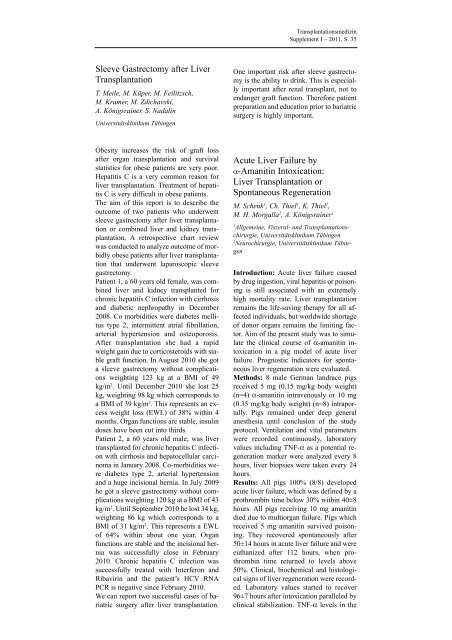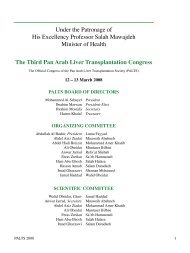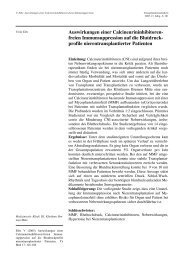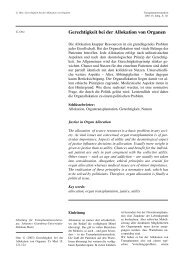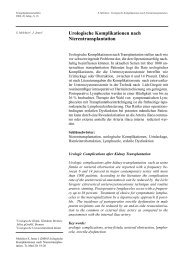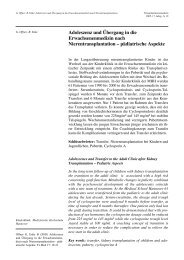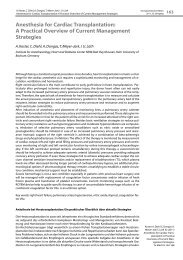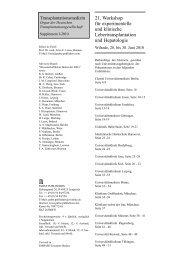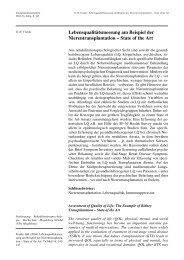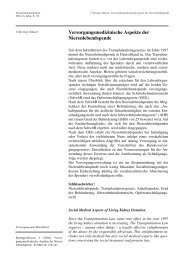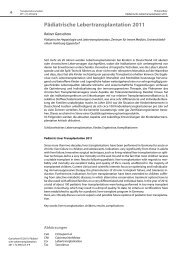22. Workshop für experimentelle und klinische Lebertransplantation ...
22. Workshop für experimentelle und klinische Lebertransplantation ...
22. Workshop für experimentelle und klinische Lebertransplantation ...
Sie wollen auch ein ePaper? Erhöhen Sie die Reichweite Ihrer Titel.
YUMPU macht aus Druck-PDFs automatisch weboptimierte ePaper, die Google liebt.
Transplantationsmedizin<br />
Supplement I – 2011, S. 35<br />
Sleeve Gastrectomy after Liver<br />
Transplantation<br />
T. Meile, M. Küper, M. Feilitzsch,<br />
M. Kramer, M. Zdichavski,<br />
A. Königsrainer, S. Nadalin<br />
Universitätsklinikum Tübingen<br />
One important risk after sleeve gastrectomy<br />
is the ability to drink. This is especially<br />
important after renal transplant, not to<br />
endanger graft function. Therefore patient<br />
preparation and education prior to bariatric<br />
surgery is highly important.<br />
Obesity increases the risk of graft loss<br />
after organ transplantation and survival<br />
statistics for obese patients are very poor.<br />
Hepatitis C is a very common reason for<br />
liver transplantation. Treatment of hepatitis<br />
C is very difficult in obese patients.<br />
The aim of this report is to describe the<br />
outcome of two patients who <strong>und</strong>erwent<br />
sleeve gastrectomy after liver transplantation<br />
or combined liver and kidney transplantation.<br />
A retrospective chart review<br />
was conducted to analyze outcome of morbidly<br />
obese patients after liver transplantation<br />
that <strong>und</strong>erwent laparoscopic sleeve<br />
gastrectomy.<br />
Patient 1, a 60 years old female, was combined<br />
liver and kidney transplanted for<br />
chronic hepatitis C infection with cirrhosis<br />
and diabetic nephropathy in December<br />
2008. Co morbidities were diabetes mellitus<br />
type 2, intermittent atrial fibrillation,<br />
arterial hypertension and osteoporosis.<br />
After transplantation she had a rapid<br />
weight gain due to corticosteroids with stable<br />
graft function. In August 2010 she got<br />
a sleeve gastrectomy without complications<br />
weighting 123 kg at a BMI of 49<br />
kg/m 2 . Until December 2010 she lost 25<br />
kg, weighting 98 kg which corresponds to<br />
a BMI of 39 kg/m 2 . This represents an excess<br />
weight loss (EWL) of 38% within 4<br />
months. Organ functions are stable, insulin<br />
doses have been cut into thirds.<br />
Patient 2, a 60 years old male, was liver<br />
transplanted for chronic hepatitis C infection<br />
with cirrhosis and hepatocellular carcinoma<br />
in January 2008. Co-morbidities were<br />
diabetes type 2, arterial hypertension<br />
and a huge incisional hernia. In July 2009<br />
he got a sleeve gastrectomy without complications<br />
weighting 120 kg at a BMI of 43<br />
kg/m 2 . Until September 2010 he lost 34 kg,<br />
weighting 86 kg which corresponds to a<br />
BMI of 31 kg/m 2 . This represents a EWL<br />
of 64% within about one year. Organ<br />
functions are stable and the incisional hernia<br />
was successfully close in February<br />
2010. Chronic hepatitis C infection was<br />
successfully treated with Interferon and<br />
Ribavirin and the patient’s HCV RNA<br />
PCR is negative since February 2010.<br />
We can report two successful cases of bariatric<br />
surgery after liver transplantation.<br />
Acute Liver Failure by<br />
α-Amanitin Intoxication:<br />
Liver Transplantation or<br />
Spontaneous Regeneration<br />
M. Schenk 1 , Ch. Thiel 1 , K. Thiel 1 ,<br />
M. H. Morgalla 2 , A. Königsrainer 1<br />
1<br />
Allgemeine, Viszeral- <strong>und</strong> Transplantationschirurgie,<br />
Universitätsklinikum Tübingen<br />
2<br />
Neurochirurgie, Universitätsklinikum Tübingen<br />
Introduction: Acute liver failure caused<br />
by drug ingestion, viral hepatitis or poisoning<br />
is still associated with an extremely<br />
high mortality rate. Liver transplantation<br />
remains the life-saving therapy for all affected<br />
individuals, but worldwide shortage<br />
of donor organs remains the limiting factor.<br />
Aim of the present study was to simulate<br />
the clinical course of α-amanitin intoxication<br />
in a pig model of acute liver<br />
failure. Prognostic indicators for spontaneous<br />
liver regeneration were evaluated.<br />
Methods: 8 male German landrace pigs<br />
received 5 mg (0.15 mg/kg body weight)<br />
(n=4) α-amanitin intravenously or 10 mg<br />
(0.35 mg/kg body weight) (n=8) intraportally.<br />
Pigs remained <strong>und</strong>er deep general<br />
anesthesia until conclusion of the study<br />
protocol. Ventilation and vital parameters<br />
were recorded continuously, laboratory<br />
values including TNF-α as a potential regeneration<br />
marker were analyzed every 8<br />
hours, liver biopsies were taken every 24<br />
hours.<br />
Results: All pigs 100% (8/8) developed<br />
acute liver failure, which was defined by a<br />
prothrombin time below 30% within 40±8<br />
hours. All pigs receiving 10 mg amanitin<br />
died due to multiorgan failure. Pigs which<br />
received 5 mg amanitin survived poisoning.<br />
They recovered spontaneously after<br />
50±14 hours in acute liver failure and were<br />
euthanized after 112 hours, when prothrombin<br />
time returned to levels above<br />
50%. Clinical, biochemical and histological<br />
signs of liver regeneration were recorded.<br />
Laboratory values started to recover<br />
96±7 hours after intoxication paralleled by<br />
clinical stabilization. TNF-α levels in the


